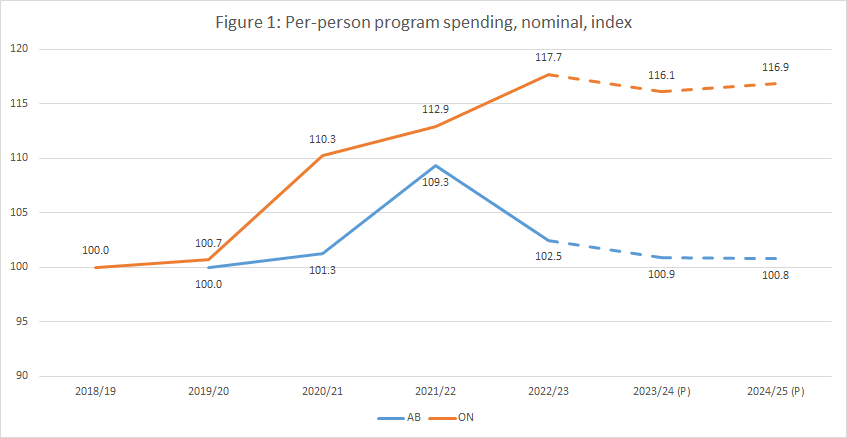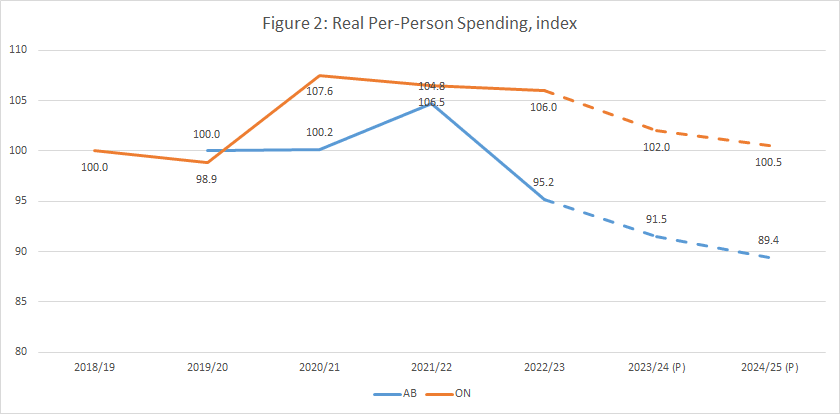On government spending—Kenney kept his word, Ford did not

In the spring of 2018, Doug Ford’s Progressive Conservative Party was elected to a majority government in Ontario. A year later, Jason Kenney’s United Conservative Party was elected to a majority in Alberta.
In several respects, the Ford and Kenney governments were elected on similar commitments. Both promised to exercise spending discipline that they argued had been absent from their predecessors’ approach to governance (Wynne’s Liberals in Ontario and Rachel Notley’s NDP in Alberta). By reducing spending, both Ford and Kenney promised to begin the process of repairing their provinces’ finances, which had deteriorated badly over the preceding decade.
Despite Alberta’s daunting deficits, the Notley government had overseen steady increases in nominal program spending (which excludes debt interest), with inflation-adjusted per-person spending also increasing slightly. The Wynne government’s approach in Ontario was similar, with increased nominal spending and essentially flat real per-capita spending until a brief pre-election spending surge, which pushed spending up further.
Ontario and Alberta both recently tabled their 2022/23 provincial budgets and it’s now crystal clear that while the Kenney government has kept its promise to change direction, the Ford government has not. Instead, Ontario’s fiscal policy has been marked by continuity rather than change following the 2018 election.
The charts below tell the story. Each case uses an index, setting spending levels during the year that the two governments took office at 100. This allows an “apples to apples” comparison of how spending trajectories have differed in the two provinces.
Chart one shows that the Ford government has continued to oversee substantial growth in nominal spending since taking office. For 2022/23, its spending on our index has increased to 117.7, which means that nominal spending has grown by 17.7 per cent. Compare that to what has happened in Alberta, where nominal spending has been essentially flat since 2019/20 when the Kenney government took office, with nominal spending growth of just 2.5 per cent.
 Source: Alberta Finance, Budget 2022; Ontario Finance, Budget 2022; Statistics Canada, Tables 17-10-0005-01 and 18-10-0005-01; calculations by authors. Note: Dashed lines represent projections.
Source: Alberta Finance, Budget 2022; Ontario Finance, Budget 2022; Statistics Canada, Tables 17-10-0005-01 and 18-10-0005-01; calculations by authors. Note: Dashed lines represent projections.Given upward pressure from population growth and inflation, holding nominal spending essentially flat for three years is not easy. Chart two illustrates this point and further demonstrates the difference between the Ford government’s approach to government spending and that of the Kenney government.
Despite frequent accusations of profligacy on the part of its predecessor, the Ford government has actually increased inflation-adjusted per-capita spending higher than it ever was under Premier Wynne, even following her government’s pre-election splurge. We see that between 2018/19 and 2022/23, the Ontario government expects a 6 per cent increase in inflation-adjusted per-person spending.
The contrast with Alberta is again striking. Over three years, program spending in Alberta (using our index that sets the year of taking office at 100) is expected to drop to 95.2 per cent, which represents a spending decrease of approximately five per cent. To be sure, this is mild compared to past fiscal consolidations (Premier Ralph Klein in the 1990s, for example) but it’s still markedly different from the loose spending approach of the Ford government in Ontario today.
 Source: Alberta Finance, Budget 2022; Ontario Finance, Budget 2022; Statistics Canada, Tables 17-10-0005-01 and 18-10-0005-01; calculations by authors. Note: Dashed lines represent projections.
Source: Alberta Finance, Budget 2022; Ontario Finance, Budget 2022; Statistics Canada, Tables 17-10-0005-01 and 18-10-0005-01; calculations by authors. Note: Dashed lines represent projections.Both the Ford and Kenney governments forecast a decline in inflation-adjusted per-person spending in coming years. The Ford government’s budget says that it will return to the spending level it inherited by 2024/25. But this would be at best a modest achievement given how critical Ford’s party has been of its predecessors’ spending. More importantly, we should take these future projections with a large grain of salt. Promising spending reductions is much harder than delivering them, and the Ford government’s failure to do so to-date should make us skeptical of a sudden change in approach in the years ahead.
The Kenney government is also committed to continued inflation-adjusted per-capita spending reductions—specifically, over the next two years, to bring spending down to 89.4 per cent of where it was when the government took office. Again, delivering these reductions will be harder than promising them, but the Kenney government’s forecasts can be taken more seriously. Why? Because it’s already delivered real per-capita reductions.
Finally, these different approaches to spending are, unsurprisingly, producing different fiscal outcomes for the two provinces. While Ontario remains mired in large budget deficits and projects rapid debt growth for years to come, the Kenney government has achieved a balanced operating budget this year after a lengthy string of deficits.
Of course, a gusher of unexpected natural resource revenue played the largest role in helping Alberta balance its books so quickly. But provincial spending choices have mattered, too. University of Calgary economist Trevor Tombe has estimated that if Alberta had followed the spending plan the Notley government had in place when it left office, the province would still have a $4 billion deficit this year. Clearly, the spending restraint illustrated above is a big part of why Alberta’s budget is now balanced and Ontario’s is not.
To be sure, Alberta has much work to do to fix all the damage done over the past 15 years. The province still carries significant debt primarily due to nearly uninterrupted deficits over this period, and should work to reduce its reliance on natural resource revenues by investing in the creation of a “rainy-day fund” and resuming contributions to the Heritage Savings Trust Fund. But Alberta has at least started the process of undoing the recent damage to provincial finances while the Ford government has not.
When they were running for office and then after taking office, both premiers Kenney and Ford promised to break from their predecessors and reduce government spending. But actions speak louder than words. The Alberta premier kept this promise while the Ontario premier has not.
Author:
Subscribe to the Fraser Institute
Get the latest news from the Fraser Institute on the latest research studies, news and events.

